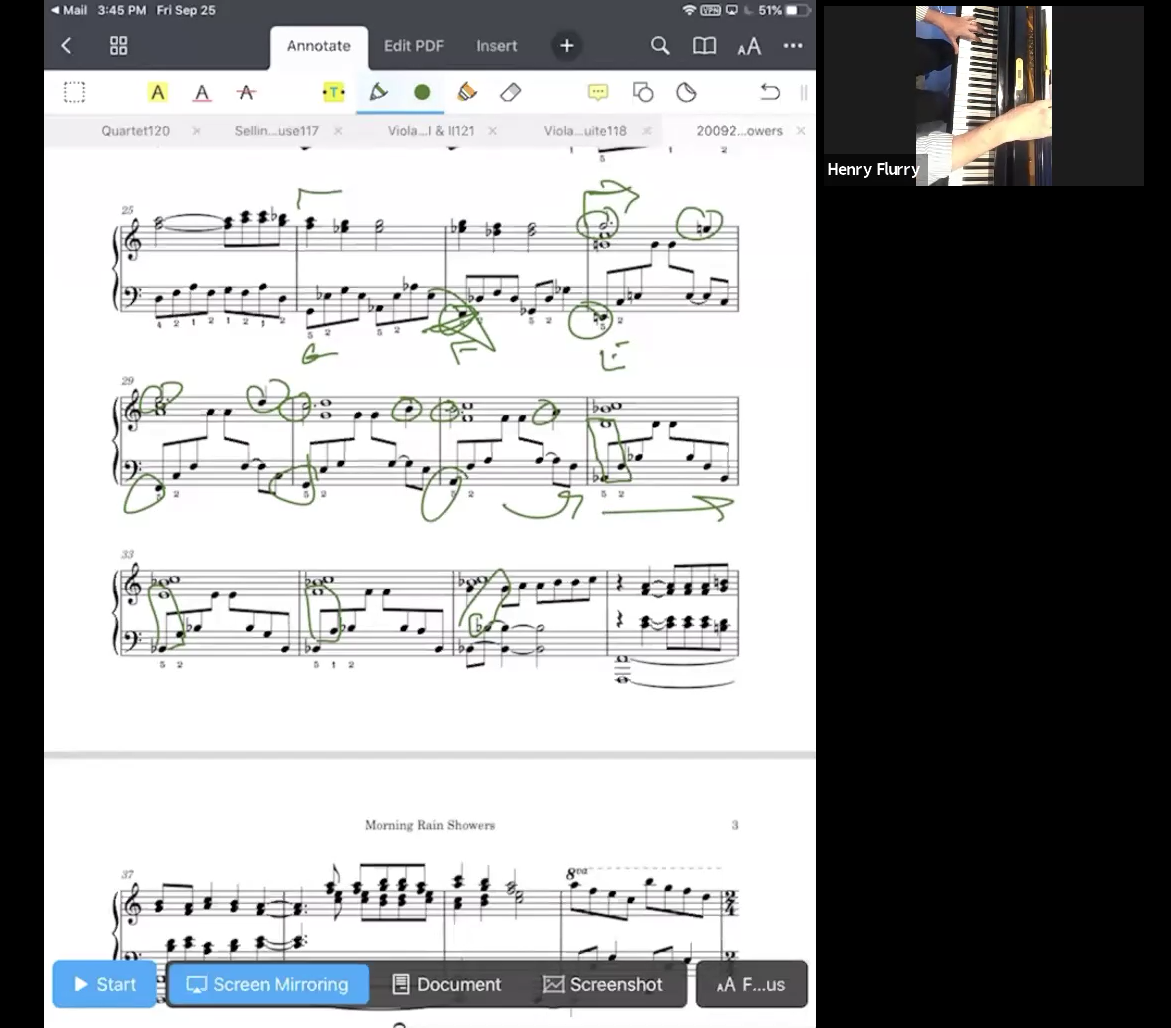
There’s no doubt about it. While better than nothing, teaching music via Zoom is far from ideal.
I am grateful to be able to see my students weekly and safely. But I miss the clarity of in-life audio, the ability to pick up subtle body-movement clues, and the lack of being able to play duets with my students.
In what seems like a part-time job, I have been on a continuous quest to find solutions to improve the remote music-lesson experience. I’ve followed and implemented all of the incremental improvements of the Zoom application, optimized my home network settings, spent hours and dollars with parents to optimize their setups, and dived deep into the depths of experimental software and hardware designed to diminish the distance of distanced, collaborative performances.
Here are a bit of what I’ve tried and learned.
The quality of the audio (my biggest concern) between me and a student is affected by bandwidth (how much sound data can we exchange), latency (how long before my student hears what I play, and vice-versa), jitter (do I get the sound at the same rate, or is it sometimes delayed, slowed down, or sped up?), and packet loss (how much audio is just completely lost in the network).
The Problem with the Internet
To teach virtually, all of our visual and audio data goes back and forth over the Internet. Data leaves my computer, travels to my router, enters my cable modem, and makes its way to the central server of our local Cable Service. If I’m lucky, my student also subscribes to cable Internet, and the data follows a similar but reverse path to my students’ computer. If my student is on DSL or cellular internet, a whole bunch of other network paths between our two Internet services are added. When my student plays for me, the same path is traversed backwards. There are a lot of places along this route where our data back and forth can be delayed, bottle-necked, or even lost.
And very frequently, the data is delayed, bottle-necked, and lost.
I envy big cities where it is common for folks to have extremely high-speed Internet and efficient networks. In Prescott, AZ, our cable Internet is currently the best bet. I have much better lesson experiences with students who also use cable modems. All of my students on DSL have suffered from poor audio and video quality. While I pay $60/month for 200 Mbps download and 20 Mbps upload, some of my DSL students are paying nearly the same price for 2 Mbps download and 0.4 Mbps upload.
Choice of Internet connectivity clearly affects lesson quality, yet I also work hard to optimize the in-house lesson setup.
Optimizing the Home Setup
I connect my computer to my router via Ethernet cable, instead of WiFi. This keeps the bandwidth as high as possible and the jitter and latency as low as possible. I use a Yeti Blue microphone (great for Zoom, but a bit slow for optimizing real-time interaction) and wired headphones.
For most of my students, I’ve purchased and loaned them external USB microphones for their computers or plug-in mics for their iOS devices. After much research and some testing, I settled upon the Samson Go Mic and iRig Mic Cast. If needed, I also loan them wired headphones with a long cord (Tascam TH-02). (Bluetooth headphones add latency and jitter, and my students who use Bluetooth inevitably forget to charge them before a lesson.) Using a microphone and wired headphones greatly improves the quality of the experience for both student and teacher.
Zoom
Zoom is my primary application for teaching. I keep it updated and use all the usual and well-documented music settings: Original Sound, echo cancellation off, manually adjusted microphone input, etc. With a student with a quality Internet connection and device, I sometimes turn on Hi-Fidelity and Stereo. They like that added realism.
At the beginning of most lessons, I have a checklist I run with my students. Is original sound on? Please play your piano, and let’s optimize the microphone level. Listen to me play – do you hear any “crunching”? If I forget to do the checklist, I know very quickly when the first few notes are played.
I run Zoom on my computer with the camera facing my face or, if pushed back, my whole torso. I have a boom mic stand for my phone, where I run a second Zoom session that focusses on the piano keyboard. That way, the students can see my face or my hands, depending upon which Zoom feed I spotlight.
 I frequently load my students’ music on my iPad, so I can share that screen to the student. We can mark up music together, or I can work out music theory questions on paper. Sometimes I’ll send the annotated music or notes to the student.
I frequently load my students’ music on my iPad, so I can share that screen to the student. We can mark up music together, or I can work out music theory questions on paper. Sometimes I’ll send the annotated music or notes to the student.
I ask students to position their Zoom camera to where I can see the side of their torso and head, their hands, and the keyboard. This gives me most of the visual cues I need to address fingering, body and arm position, and tension.
But Zoom audio is problematic. It shifts in tempo. Sometimes the shift is subtle, so you are not sure if your student’s rhythm is accurate. Sometimes the shift is dramatic, so you have no idea what your student played. It also shifts the pitch: I’ve had student piano’s come in a full half-step off in pitch for an entire lesson – I initially was very confused. I now always assume that the rhythm and pitch coming in are not necessarily accurate.
CleanFeed
For my more advanced students, I frequently switch to CleanFeed, which requires only a Chrome browser. I run it in Trial Pro Mode so that I can optimize the audio and have confidence in what I hear from the student. The gentle pinging of the middle-C watermark quickly fades into the background and is not noticed by either of us. We keep the Zoom video on, with the audio turned off, and use CleanFeed for our audio. If we each don’t remember to shut down Clean Feed also after a lesson, I accidentally continue to broadcast my putzing-around noise to my student.
Playing Together
Nothing motivates a student like playing duets or concertos. I’ve become fairly good at playing “one-sided” duets. I play my part, counting carefully to keep a steady tempo, so that the student can play their part along side with me. What I hear back from the student is frequently about a second behind the timing it should be. (Humans performing together can tolerate a lag or latency of about .03 seconds, or 30 milliseconds.) So, I seek a balance between ignoring the timing of what I hear back and listening to whether or not the student is playing what I expect. However, I cannot follow a students’ rubato or fermatas, nor can I tell if a student is playing accurately.
Can I tell you how much I’ve missed practicing duets or concertos with my students? Or even participating in the simplest teaching moment of playing a learning piece in unison?
This is where most of my recent research with optimizing remote-lesson audio has focussed. How can I create a more real-time lesson experience, where the student and I can play together? I want us to be able to follow each other. I want to hear our mutual groove that I can discuss questions related to ensemble playing. I want to feel that connection that only performing together can offer. Is this even possible?
The answer is … maybe. I’ll cover that in my next post.
One thought on “What I’ve Learned About Technologies for Remote Music Lessons”